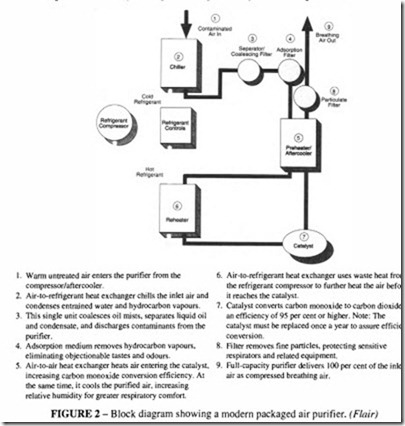Carbon monoxide
This is the most insidious danger faced by compressed air users. As a contaminant of compressed air, carbon monoxide is usually introduced via the intake port of the compressor. The compressor power drive itself (exhaust fumes from the internal combus tion engine) can be a major source of CO. In addition, thermal decomposition of the compressor lubricant due to high local temperatures can result in the formation of CO within the compressor.
The toxicity of carbon monoxide has, by the nature of the CO gas molecule, a 300 times greater affinity for the haemoglobin molecule than does oxygen. At levels of only 2% CO/haemoglobin involvement in the blood stream, disturbances to the psychomotor functions can occur, but this does not normally become significant until 5% levels are reached. At elevated pressures, however, absorption may be more rapid and complete, and any impairment to the higher functions may be disastrous.
A 2% involvement corresponds to about 10 ppm of CO so it can be appreciated that the adherence to air purity standards is absolutely essential.
The difficulty in removing CO from the air is due to its physical and chemical properties.
components on their active centres. Water vapour in particular exhibits strong poisoning characteristics for hopcalites. To ensure a reasonable life for the catalyst, compressed air must be ultra-dried by the use of desiccants. Since the effectiveness of the hopcalite is actively limited by moisture, it has become common practice to assume that the catalyst becomes inactive when a certain level of humidity is exceeded. For this reason, some systems utilising a hopcalite filter include a colour change indicator based on a colour sensitive material. This type of indicator is a safety device and measures air moisture content not CO content. Where fitted at the outlet, periodic testing for CO is advised, because the hopcalite would fail before the indicator changes colour. Modern purifiers avoid this problem by incorporating the indicator throughout the length of the cartridge, visible through the transparent walls of the housing. Such a construction warns of the presence of moisture before it reaches the hopcalite.
